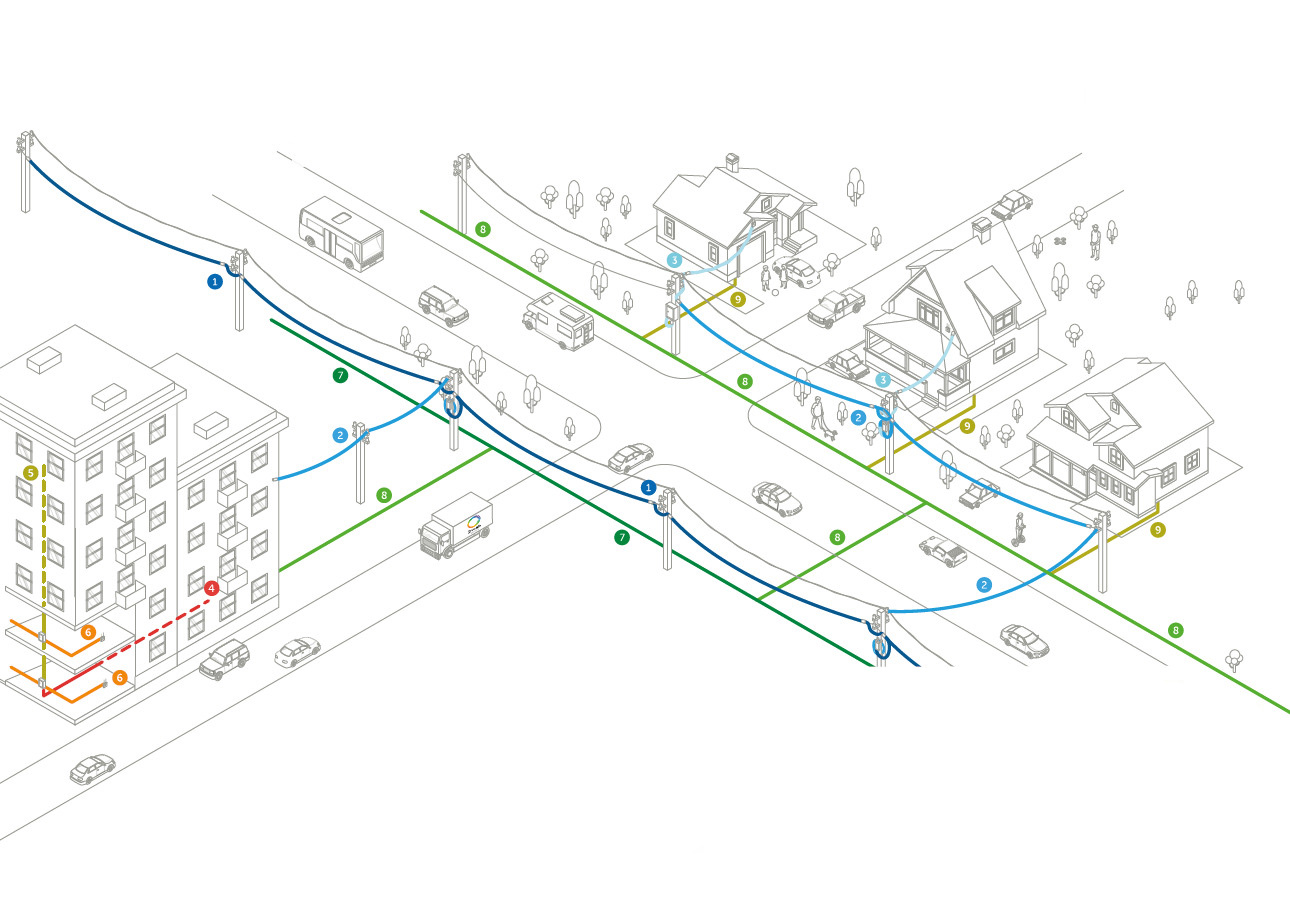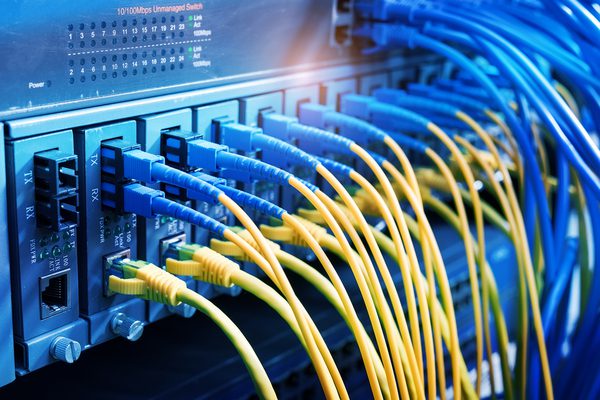In today’s digitally driven world, connectivity is no longer a luxury; it’s a necessity. Central to this connectivity is the OSP fiber network, also known as the outside plant fiber optic network. These networks form the backbone of telecommunications, ensuring high-speed data transfer over long distances. This comprehensive guide will walk you through the essentials of OSP design, OSP planning, and OSP management, helping you better understand the components, roles, and strategic importance of these networks.
What is an OSP network?
OSP, or Outside Plant, refers to all the physical cabling and supporting infrastructure (such as conduits, poles, enclosures, and splices) located outside buildings. An OSP fiber network specifically involves fiber optic cables deployed across vast geographic areas to connect central offices, data centers, neighborhoods, and individual homes. Think of it this way: a cable to your adjacent room is an inside plant, a cable to your neigbour’s house is an outside plant.
Key components of OSP in fiber optics
• Fiber optic cables
• Conduits and ducts
• Splice enclosures
• Handholes and manholes
• Poles and aerial supports
These elements come together under the careful orchestration of OSP project managers, OSP designers, and OSP engineering managers to deliver seamless connectivity.
OSP fiber design: crafting efficient networks
OSP fiber design is the foundational step in building a successful network. It determines how the fiber optic infrastructure will be deployed across a geographical region.
Goals of effective OSP fiber design
- Ensure minimal signal loss
- Facilitate scalability for future expansions
- Maintain cost-efficiency, meaning easy access to certain network points while maintaining security
- Account for geographical challenges
FTTH OSP design (Fiber to the Home) is a sub-discipline that focuses on bringing fiber directly to individual homes or residences. This requires meticulous planning to ensure maximum coverage with minimum physical disruption.
Considerations for OSP network design
- Route planning – determining optimal pathways for laying fiber
- Environmental factors – taking into considerations current and possible future obstacles
- Regulatory compliance – local codes, permits, right-of-way
- Reliability – ensuring secure network points and backup routes for fault tolerance
OSP planning and project management
Planning an outside fiber cable plant project involves a combination of strategic foresight, engineering know-how, and logistical coordination. OSP planning is the phase where timelines, budgets, and resource allocations are established.
Key roles in OSP planning
- OSP construction manager oversees field construction activities and ensures adherence to design specs. He is responsible for workers, linemen and machinery being on site on time, and doing everything right.
- OSP engineering manager coordinates a design team and liaises with permitting organizations, stakeholders and everyone involved to align engineering efforts with project goals and schedule.
- OSP project manager manages overall timelines and budgets, and he’s the one to be blamed for all blunders, which will certainly occur.
Project management tools and OSP mapping technologies are critical at this stage. While everything still can be carried out in AutoCAD, even OSP splicing data, one can use splice.me for drastically speeding up this process.
OSP management and maintenance
Once an OSP fiber network is deployed, it requires ongoing maintenance and upgrades. No fiber network stays as-built for longer than couple weeks. OSP management involves proactive monitoring and reactive servicing to ensure network stability.
Best practices for OSP management
- Use of GIS for OSP mapping and asset tracking. The idea here is that the network map data should be easily accessible though safe from third parties, could be exported or printed to be handed to linemen, and should be clean, clear and understandable.
- Scheduled inspections and maintenance routines. A service provider usually has a schedule for checking the integrity of cabinets with switches, condition of back-up batteries, etc. The network owner should always foresee if some new construction could disrupt his network, whether it’s a new road construction, or planned utility poles substitution.
- Implementation of fault detection systems. It’s always better to get instantly signaled of a link fault from monitoring equipment, than from outraging clients.
- Record-keeping of fiber splices, routes, changes and everything. Keeping OSP splicing data in splice.me is a must-have.
An efficient OSP and ISP fiber design strategy bridges the gap between outdoor and indoor networks, creating a unified infrastructure that supports modern demands.
How OSP differs from ISP and other network types
While OSP (Outside Plant) fiber networks are vital to modern connectivity, it’s important to distinguish them from other types of infrastructure – particularly ISP (Inside Plant) networks and wireless technologies.
OSP vs. ISP in fiber optics
OSP (Outside Plant) refers to all fiber optic infrastructure located outside of buildings. This includes buried cables, aerial lines, splice closures, manholes, and outdoor cabinets. The primary focus is long-distance, high-capacity data transmission between network nodes like central offices, hubs, aggregation points.
ISP (Inside Plant) refers to network equipment and cabling housed inside buildings. This includes switches, routers, patch panels, server racks, and internal fiber or copper cabling. ISP design focuses on data distribution within facilities, like data centers or telecom buildings.
Key differences:
| Feature | OSP (Outside Plant) | ISP (Inside Plant) |
| Location | Outdoors, across cities and regions | Indoors, within buildings and rooms |
| Environment | Exposed to weather, terrain, regulations | Controlled indoor conditions |
| Components | Fiber cables, ducts, poles, enclosures | Patch panels, routers, internal fiber |
| Design Focus | Long-distance transmission and routing | Local distribution and switching |
| Durability Needs | High-resistant to environmental factors and accidents | Moderate – standard equipment protection |
OSP vs. wireless and satellite networks
While OSP networks involve physical fiber optics, wireless and satellite networks transmit data through space.
| Technology | OSP Fiber | Wireless | Satellite |
| Medium | Fiber optic cables | Radio waves | Microwave/radio waves |
| Speed | Extremely high | High (variable) | Lower latency and speed |
| Reliability | Very high | Can be affected by obstacles or interference | Affected by weather and signal delays |
| Use case | Core infrastructure, backhaul, FTTH | Mobile data, last-mile access, uninhabited areas | Remote areas, global coverage |
OSP fiber offers the highest reliability and bandwidth, making it the backbone of all modern networks, including those that serve wireless or satellite end users.
Notable OSP surveys and analytics
1. UTC Underground Fiber Network Survey (Spring 2021)
Conducted by the Utilities Technology Council, reaching 268 North American utilities, with responses from 28 utilities (~25%). Key findings:
- About 45% of underground OSP fiber cables have been in service for over 20 years.
- Approximately 82% of utilities reported operating 100–500 miles of fiber, with many having significantly more.
- The average network age ranged 11–15 years, with one-third dating beyond two decades.
2. NTCA (Rural Broadband) Broadband/Internet Availability Survey (2023)
Survey of 205 rural broadband providers across 44 US states. Notable stats:
- 98% use fiber to the premises (FTTP) in at least part of their coverage area.
- 5% of locations surveyed are served by optical/fiber infrastructure, up from 79.3% in 2022.
- 1% of customers could access ≥1 Gbps downstream speeds; 86.7% have upstream ≥ 20 Mbps.
3. Cable Operator Fiber Outlook (CommScope) – circa 2020
Survey of cable operators deploying fiber amid the shift toward Distributed Access Architecture (DAA), which shows the industry’s strategic investment in OSP fiber to enhance capacity and reduce maintenance complexity. Findings include:
- 62% are actively implementing DAA upgrades.
- 82% see increased fiber capacity as the primary advantage, while 42% note easier OSP maintenance with fiber enhancements.
4. “2050 Project” by ATX Networks
A survey exploring the evolution of HFC networks to full fiber and DOCSIS 4.0 indicates ongoing transition decisions where OSP fiber plays a critical role across hybrid and all-fiber models. Highlights:
- 55% of operators expect DOCSIS 4.0 deployment by end of 2027.
- Nearly 20% feel that DOCSIS 3.1 reduced the urgency to migrate fully to fiber via FTTH
Don't hesitate! Start using splice.me
Create, manage, control all your fiber splicing in one place, fast and easy




